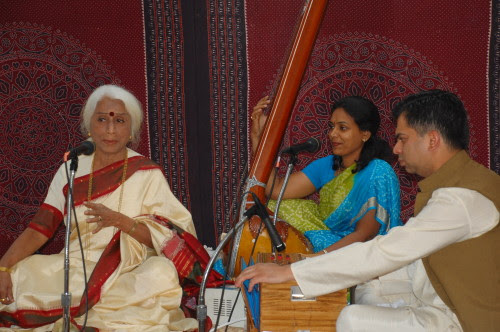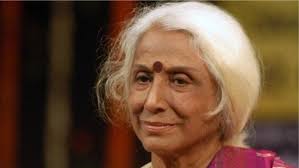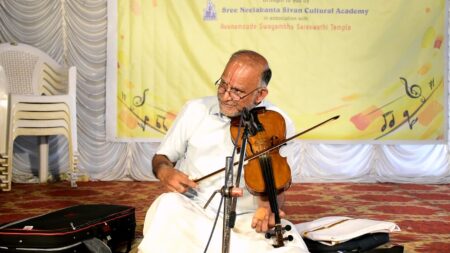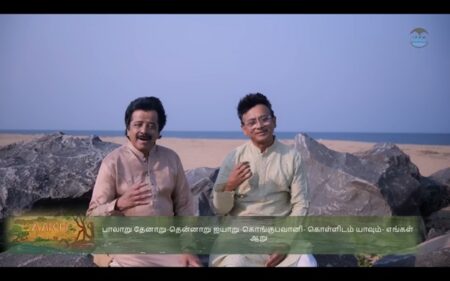Kirana Gharana vocalist, Dr. Prabha Atre left an indelible mark on the world of music.
Renowned Hindustani classical vocalist, Dr. Prabha Atre, passed away at the age of 92 after succumbing to a heart attack at her residence in Pune on Saturday. She was scheduled to perform at Mumbai today evening . The music world is left in sorrow, already grappling with the recent loss of classical maestro Ustad Rashid Khan.
Recipient of all three Padma awards, Prabha Atre was a multifaceted artist who left an indelible mark on the world of music. A true luminary, she excelled in various facets of musical expression. Trained under the illustrious Kirana Gharana giant, Pandit Sureshbabu Mane, her journey in music took an unconventional turn after his untimely demise. Deeply connected to her guru, Prabha Atre chose to tread her musical path without adopting another mentor. Instead, she embarked on a self-guided musical exploration, drawing inspiration from luminaries like Ustad Amir Khan and Ustad Bade Gulam Ali Khan.
According to Dr. Atre, the key to becoming a skilled artist lies in attentive listening without prejudice. She emphasized the importance of understanding the intricate nuances of ragas, appreciating the subtle movements of notes, and grasping the intricacies of Layakari. For her, borrowing from various musical forms was an art in itself, with the ultimate goal of seamlessly merging these influences into her own music, ensuring that the listener experienced a harmonious amalgamation rather than isolated elements.
Prabha Atre didn’t limit herself to Hindustani classical music; she also drew inspiration from other forms. The impact of Carnatic music is evident when she sings phrases in ragas like Yaman with typical Carnatic oscillations on the notes Ga and Re.
According to her, when someone borrows something, it should be merged into one’s music. The listener should not feel its separate existence. “I listen not only to Hindustani and Carnatic music but also to other forms like Arabian music, film music, light music, etc. I have borrowed a lot from all these forms, but the listener will not know what I borrowed from where, as they are merged into my own music,” she once said.
Unique Sargam singing
Prabha rose to fame through her recordings of ragas Marubihag and Kalavati. She omitted the shuddha Madhyam in Marubihag, using it sparingly. Another notable contribution to raga rendition was her development of a distinctive style of Sargam.

Influenced by Ustad Amir Khan’s Sargam, Prabha crafted her own rendering, deeply inspired by Ustadji but distinctly different from him. She later earned a doctorate in Sargam. Prabha had explained, “In Raga Shyam Kalyan, I sing phrases that reflect Kalyan Ang, as the Raga’s name is Kalyan. Similarly, in Jogkauns, phrases reflecting Jog and Kauns should be rendered, while phrases like Pa Dha NI (Ni being Komal) should not be used. Some Raga names need revision; for instance, Gorakh Kalyan, lacking any Kalyan Ang, should be renamed without Kalyan. The same applies to Basant Mukhari, which can be called Mukhari Bhairav as it mirrors Bhairav Ang. Currently, there are numerous forms of the same Raga in circulation.”
Prabha advocated for standardizing the raga format, suggesting that if disagreements arise among artists, various formats should be assigned numbers, such as format 1, format 2, etc. This approach would prevent confusion among students regarding the authenticity of the raga format.
As a composer
Prabha Atre composed Khayals, Bandishes, and Taranas in around 90 ragas. Her venture into composing began when she crafted an opera while working at All India Radio in Ranchi. Her initial classical composition, “Jaagun Main Sari Raina” in Marubihag, catapulted her to fame.
Prabha undertook various experiments in her compositions. Typically, Bandishes in Ektal commence from the 1st or 7th beat, but the Marubihag Bandish mentioned above, or the Bandish in Gaud Malhar “Chaaye Badara,” starts from the 8th beat. Her Lalat Bandish “Mana Sumirat” starts from the 9th beat, while her renowned Bandish “Tan Man Dhan” (Raga Kalavati) begins with the 12th beat of the Tala. The same distinctive approach extends to her Bandishes in Rupak Tala.
However, Prabha’s Bandishes like “He Man Tore Sharana” (Raga Durga), “He Shiva Shankar” (Raga Shankara), and “Devo Mohe Daras” (Raga Malkauns) start from the 4th beat, adopting a structure of 2+2+3. Her composition “Sundar Shyam” (Raga Bhimpalas, Tal Jhaptal) unfolds between the 8th and 9th beats of the Tala.
Prabha Atre was conscious of choosing appropriate subjects for specific Ragas. For instance, in Bhairav and its variations or Raga Shankara, she composed poetry dedicated to Lord Shiva. In Durga, she created compositions honoring Goddess Durga. Recognizing Shuddha Sarang as an afternoon raga, she composed the Khayal “Tapan Lagi Chahu Aur,” describing the afternoon atmosphere.
Some of her compositions presented a non-traditional interpretation of a raga. In Madhuvanti, where compositions typically have their Sam on Re, Prabha’s Khayal “Manmohana Shyam” placed its Sam on Ni.
Influenced by the Carnatic music form Ragam Tanam Pallavi, she crafted a one-line composition: “Om Namo Shivaya” (Raga Bhairav, Tal Jhaptal), rendered as both Sthayi and Antara. Her Taranas reflected the impact of Swarams as rendered in Carnatic music.
Prabha believed in creating separate compositions for male and female singers. Disliking the idea of a man singing compositions like “Jhan Jhan Payal Baje” or “Sas Nanand Mohe Degi Gali,” she crafted distinct compositions for males. For instance, if the composition contained the words “Piya Ghar Nahi,” she felt that the male singer should render it as “Sakhi Ghar Nahi.”
She also emphasized the importance of being well-versed in a raga before composing bandishes, likening it to understanding a person by spending time with them. Mastering a raga, according to her, requires many years.
Prabha strongly believed that the primary purpose of any classical composition is to showcase the raga rather than its poetic content. Consequently, her compositions were brief, as she thought that an excess of words would divert the listener’s attention away from the essence of the raga rendition.
Eschewed Tradition
Prabha Atre believed that new books should be written on music to reflect the current way of rendition. “Just because Indian classical music is traditional, we should not stick to mere tradition itself. We should refine it, as time changes. For example, things like Waadi Samwaadi or Pakad of a raga is not needed. Instead, students should be told as to what notes in raga are prominent in ascent, and what notes are prominent in descent,” She had said.
Thus she opened her own Gurukul, which tries to combine the strengths of both Gurukul and college education. In universities, there should be special courses for classical music, film music, folk music, light music, music composing, recording, as each of the above requires different types of training.”
She was also against the concept of raga Samay, and raga rasa. She believed that every raga has its own Laya, and its own temperament, but it has no particular rasa or mood. The mood of the artist, and the listener’s mood decide the raga rasa for that point in time. Often words of the composition also decide the raga rasa.”
Prabha Atre has created many new ragas like Shivkali, Shivani, Madhurkauns, etc.
With her gifted voice and brilliance, open-minded attitude, esthetic approach, and objective way to look at music, Prabha Atre has made a great contribution in Indian classical music




